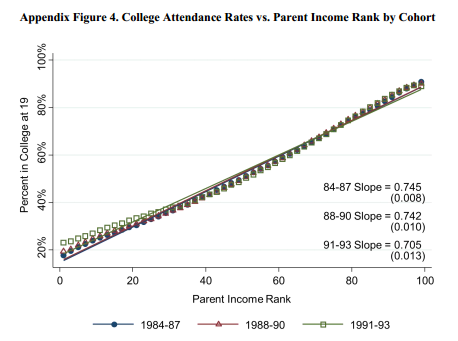Yesterday, I argued that poor kids do not get traditional media jobs because growing up poor puts them so far behind their non-poor peers that they get out-competed for the scarce media jobs. I think the following graph, which tracks likelihood of college attendance at age 19 by parental income, is very telling on this point:

That piece was short and did not cover everything there is to say on the topic. After reading reactions to the piece, I want to add the following:
- The class-based discrepancies are probably more pronounced for traditional media jobs than social medial jobs, which are really more like communications jobs. This is because social media jobs are probably not as selective. If true, that means that you would expect unpaid internships in the realm of social media to have a somewhat greater effect on poor kids than unpaid internships in traditional media. (ht Amber A’Lee Frost)
- The class-based discrepancies are not simply rich versus poor. As seen in the graph, college attendance at 19 rises in lock step with parental income. So what you have is more of a sliding scale of class-based credential-driven exclusion. Thus, it’s not that only the rich win things like media internships; rather, it’s that the richer you are, the more likely you are to win one. And, I theorize that this will largely be the case whether you pay for the internship or not.
- Credentials are not the only non-cost factors that work against poor kids getting into media. Social capital — the people you know and the things they are capable of helping you get — also plays a role, just like any other industry. Perhaps even more significantly, cultural capital — the ability to perform upper-classness — also likely plays a role. People from high socioeconomic backgrounds, like those in media, have certain values, cultures, behavioral norms, entertainment preferences, food preferences, and so on. The ability to fit in to that culture almost certainly has an impact on candidate selection.
Cultural capital is an especially insidious filtering agent precisely because it runs under the radar. Cost problems are the most obvious things people see. Credential and social capital problems follow shortly thereafter. But very few seem to pay much mind to the way in which high socioeconomic status jobs have their own cultures and not everyone can fit into them very well.
This lack of fit (as it is often dubbed) is explicitly relied upon as an intangible way to screen applicants. As Nitasha Tiku points out, it is used in Silicon Valley to screen out women who do not fit with the (male-dominated) culture. It no doubt screens out people of color who are not able to successfully code-switch into upper-class whiteness. And it militates against poor people of all sorts who don’t behave the way upper class people do and may therefore come across as a bit ill-fitting. This can result in them losing competitions for jobs, especially when firms are making close calls in somewhat soft and impressionistic industries like media. It can also result in them being overlooked for promotions.